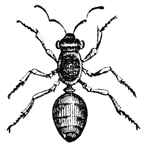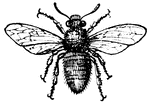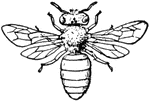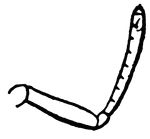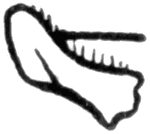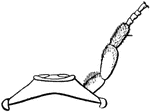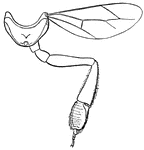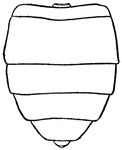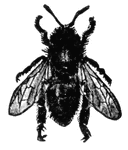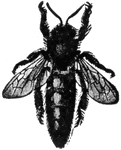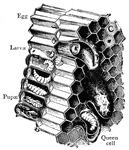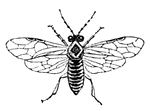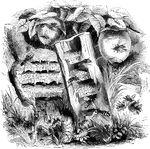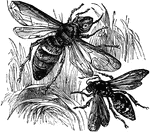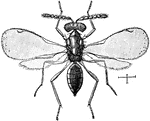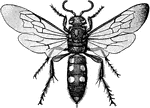Clipart tagged: ‘Hymenoptera’
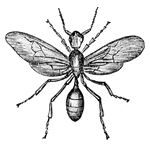
Red Ant
The red ants, here a winged male, are produced in great numbers at particular times of the year.
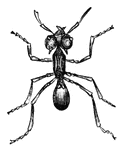
Red Ant
The red ants, here a wingless neutered male, are produced in great numbers at particular times of the…
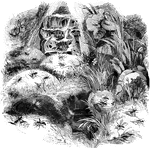
Ants and Their Structures
"This tribe, which includes the various kinds of Ants, is composed entirely of insects which live in…
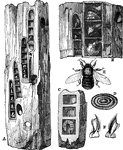
Carpenter Bee
"A, B, C, tunnelings of the carpenter bee; E, the carpenter bee; D, a partition; F, teeth, magnified"…
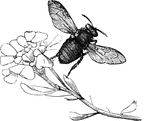
Drone Bee
"The working bee, for collecting wax, enters a flower, the stamens of which are loaded with pollen.…
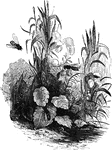
Honey Bee
"They are said to have originated in Greece, but have since spread all over the world; they live in…

Mason Bee
"The Mason Bee, Osmia, of which there are many kinds, makes its cells in spaces from which…
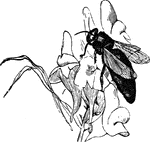
Queen Bee
"The queen bee is larger and longer than the other bees; she moves in a slow and majestic manner, and…

Working Bees
""The working bee, for collecting wax, enters a flower, the stamens of which are loaded with pollen.…

Bees Secreting Wax
"The secretion of wax, it would appear, goes on best when the bees are in a state of repose, and the…
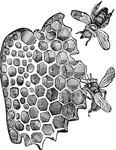
Cells of Honey Bees
"The hexagonal cells for the honey are build upon precisely that mathematical angle which affords the…

Nest of the Carder Bee
"The elevation of the dome, which is all built from the interior, is from four to six inches above the…
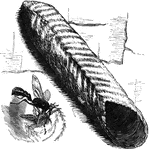
Dauber
"A South American genus, Pelopaeus, allied to the preceeding, is called the Dauber, from its…
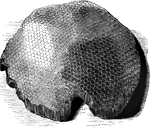
honey-comb
"The comb is made of wax, found in various plants, but which is also secreted by the bees themselves…

Hornets and Nest
"The Hornets resemble the Wasps in their habits, but but they are noted for their spitefulness and the…

Ichneumon
The insects of the Ichneumon family have long,slender bodies, long ovipositors and long antennae.
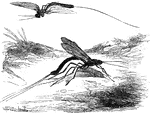
Ichneumon
"The ichineumons, with long ovipositors, as the European species, Ichneumon manifestator, seek…
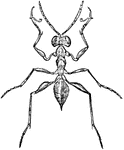
Ichneumon Fly
"Gonatopus contortulus. A genus of ichneumon-flies of the family Proctotrupidae and subfamily Dryininae,…
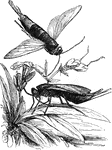
Sawfly
"On the continent of Europe the Sirex gigas often appears in immense numbers, and does great…
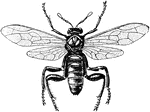
American Sawfly
The American Sawfly (Cimbex Americana) is an insect with an ovipositor resembling a saw blade.
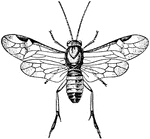
Larch Sawfly
The Larch Sawfly (Pristiphora erichsonii) is an insect resembling a black wasp in the Tenthredinidae…
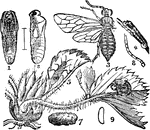
Strawberry Sawfly
"Strawberry False-worm (Emphytus maculatus). 1, 2 pupa, ventral and lateral views (line shows natural…

Parasite Wasp Cocoon
The cocoon of Sigalphus curculionis, a species of parasitoid wasps. These insects use other insects…
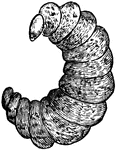
Parasite Wasp Larva
The larva of Sigalphus curculionis, a species of parasitoid wasps. These insects use other insects as…

Parasite Wasp Pupa
The pupa of Sigalphus curculionis, a species of parasitoid wasps. These insects use other insects as…
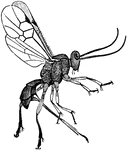
Female Adult Parasite Wasp
The female adult of Sigalphus curculionis, a species of parasitoid wasps. These insects use other insects…
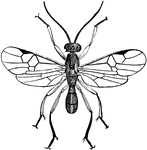
Male Adult Parasite Wasp
The male adult of Sigalphus curculionis, a species of parasitoid wasps. These insects use other insects…
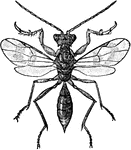
Embolimus Wasp
Embolimus americanus is a species of wasp belonging to the Proctotrupoidea superfamily of various wasps.

Dorsal View of Ensign Wasp
The dorsal view of the Ensign Wasp (Evania laevigata), an insect in the Evaniidae family.
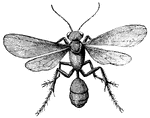
Mud Wasp
Wasps are in the Order Hymenoptera. They are carnivorous and only the female stings to paralyze its…

